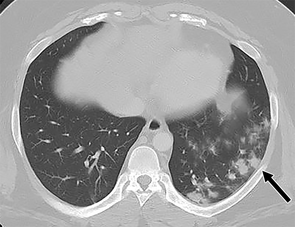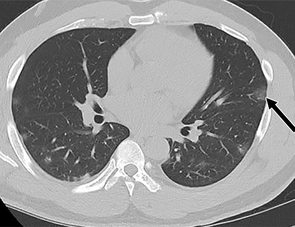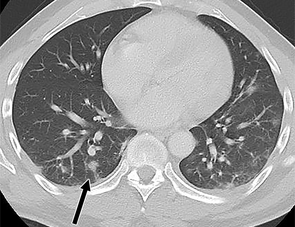Abdominal Pain: An Unusual -- But Not Rare -- COVID-19 Presentation
Abdominal CT scans show evidence of COVID-19 infection in lung base.



Fever. Cough. Shortness of breath. These are what have become known as the classic, tell-tale COVID-19 symptoms. But, there’s a different, less common, one that should alert you to possible infection – abdominal discomfort.
Recent literature has revealed that as many as 20 percent of patients present to the hospital with a digestive symptom, such as diarrhea, vomiting, pain, accompanying their respiratory symptoms. And, roughly 5 percent show up with an abdominal complaint alone.
This is where abdominal radiologists can play an integral role, said industry experts in a recent article published in the American Journal of Roentgenology. A team, led by Abraham Dachman, M.D., professor of radiology and abdominal imaging specialist with UChicago Medicine, shared three cases where patients were referred for abdominal imaging and providers distinguished findings indicative of COVID-19 infection in the lung base.
“It’s important not to be lulled into a false sense of security by a chief complaint of abdominal pain,” Dachman wrote. “The fact that we observed several patients presenting in this way in such a short time period suggests that although abdominal symptoms are an unusual presentation of the infection, they are not rare, and abdominal radiologists must be on the lookout to diagnose COVID-19, even when it is not suspected clinically.”
In the following three cases, abdominal radiologists were the first to raise concerns about potential COVID-19 infection.
Case 1: A 26-year-old man with a history of diabetes and high blood pressures presented to the hospital with fever, chills, nausea, vomiting, diarrhea, and weakness – but, no respiratory symptoms other than mild shortness of breath. A physical exam revealed mild abdominal tenderness, slight rapid breathing, and tachycardia. Abdominal and pelvic CT revealed peripheral nodular airspace and ground-glass opacities in the lung base, and subsequent reverse transcriptase-polymerase chain reaction (RT-PCR) testing confirmed COVID-19. The patient was admitted to the hospital with a primary diagnosis of diabetic ketoacidosis, secondary to COVID-19 infection.
Case 2: A 40-year-old man came to the hospital with fever, chills, nausea, vomiting, diarrhea, and intermittent abdominal pain. He had no specific respiratory symptoms other than mild shortness of breath. A chest X-ray was normal, but an abdominal CT revealed peripheral nodular ground-glass opacities in the lung bases, as well as a renal mass on the left side with fluid attenuation. RT-PCR testing confirmed viral infection, and the patient was admitted to the hospital with a primary diagnosis of uncontrolled vomiting that was secondary to COVID-19.
Case 3: A 50-year-old man with a history of gastric ulcers and a partial gastrectomy presented with fever, epigastric abdominal pain, right flank pain, and diarrhea, but with no cough or shortness of breath. An abdominal CT scan to investigate tenderness revealed bibasilar peripheral nodular ground-glass opacities characteristic of COVID-19. RT-PCR testing confirmed COVID-19 infection, and the patient was discharged home for self-quarantine.
Because these findings first appeared on abdominal scans, Dachman wrote, it’s important for all radiological sub-specialties to be aware that COVID-19 can produce abdominal complaints.
“Careful evaluation of the lung bases for the typical nodular, peripherally distributed ground-glass opacities may lead to the correct diagnosis before progressive respiratory manifestations,” he wrote. “An early diagnosis is helpful not only in patient care, but also in allowing healthcare workers to be prepared with the appropriate personal protective equipment.”
What is the Best Use of AI in CT Lung Cancer Screening?
April 18th 2025In comparison to radiologist assessment, the use of AI to pre-screen patients with low-dose CT lung cancer screening provided a 12 percent reduction in mean interpretation time with a slight increase in specificity and a slight decrease in the recall rate, according to new research.
The Reading Room: Racial and Ethnic Minorities, Cancer Screenings, and COVID-19
November 3rd 2020In this podcast episode, Dr. Shalom Kalnicki, from Montefiore and Albert Einstein College of Medicine, discusses the disparities minority patients face with cancer screenings and what can be done to increase access during the pandemic.
Can CT-Based AI Radiomics Enhance Prediction of Recurrence-Free Survival for Non-Metastatic ccRCC?
April 14th 2025In comparison to a model based on clinicopathological risk factors, a CT radiomics-based machine learning model offered greater than a 10 percent higher AUC for predicting five-year recurrence-free survival in patients with non-metastatic clear cell renal cell carcinoma (ccRCC).
Could Lymph Node Distribution Patterns on CT Improve Staging for Colon Cancer?
April 11th 2025For patients with microsatellite instability-high colon cancer, distribution-based clinical lymph node staging (dCN) with computed tomography (CT) offered nearly double the accuracy rate of clinical lymph node staging in a recent study.